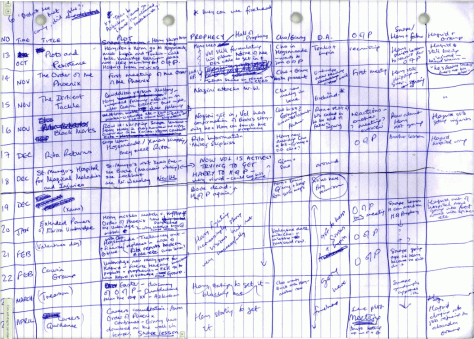A book map is a visual representation of a book’s contents. This allows for easy analysis of elements and can reveal gaps in the content of a nonfiction book or the storyline of a novel. You may have used a book map without even realizing that’s what you were doing. It’s really just a visual way of rendering an outline. You may also have heard book maps called story grids or plot charts. Anything more complex than a simple outline could be called a book map.
There are many different ways to map a book, and I think often writers find them by accident, just out of the necessity of keeping track of a complex work. I know that was the case for me.

The world’s most famous book map is probably J.K. Rowling’s book map for Harry Potter and the Order of the Phoenix, which was shared in a workshop by Scholastic Books Editor Cheryl Klein, the continuity editor for the series in the US.
If you open Rowling’s chart in a large window, you can see that she has chapter numbers down the leftmost column, and then next to that her timeline, showing the month in which that chapter takes place. In addition to a description of the contents of the chapter, she has columns for the various characters and themes that are critical to the story. This is just the map for Chapters 13–24 of one book in a seven-book series. So Rowling must have had dozens of these, in addition to her other notes and research materials.
When to Use a Book Map
Like outlining, book mapping can be done at the creative stage, to help you plan. But I tend to use them when editing. In other words, I write from an outline, but I edit from a map.
With client books, I often map out the contents while I’m editing so I can ensure that everything is as it should be. If it’s not, the book map helps me show the client what the problem is and how to solve it.
A table-of-contents style outline works well for most informational nonfiction, but sometimes we need more detail than an outline can provide. A book map can show when necessary elements are missing.
In book-length fiction and narrative nonfiction, we may detect an imbalance, such as too much time being spent on one subplot and not enough on another. The book map will reveal these kinds of problems. A linear outline will almost always be insufficient in these cases because of the number of characters and subplots to keep track of. A book map can track multiple plot lines more effectively than a linear outline.
Consider using a book map in these circumstances:
- When chapters contain multiple elements to keep track of
- When you need to quantify imbalances in a story or in the treatment of a topic
- When a linear outline is insufficient
In future posts, I’ll explain some of the different ways of making a book map, and what to do with it once you have one.